
About Andrew Cusack
 Writer, web designer, etc.; born in New York; educated in Argentina, Scotland, and South Africa; now based in London.
Writer, web designer, etc.; born in New York; educated in Argentina, Scotland, and South Africa; now based in London. read more
News
Blogs
Reviews & Periodicals
Arts & Design
World
France
Mitteleuropa
Knickerbockers
Argentina
The Levant
Africa
Cape of Good Hope
Netherlands
Scandinavia
Québec
India
Muscovy
Germany
Academica
The Continued Decline & Fall of the International Herald Tribune
The New York Times ‘tightens the leash’, shutting IHT website and redesigning newspaper as Times-lite; Herald-Trib loyalists cry foul
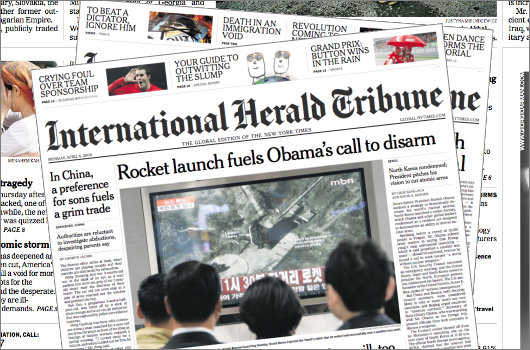
THE SAD DECLINE of one of the newspaper world’s most historic titles is continuing as the entire industry faces the challenges of the twenty-first century. The International Herald Tribune recently suffered a host of changes on the order of its proprietor, the New York Times, that have continued to assault the Paris-based newspaper’s individual identity. The paper’s website, iht.com, has been shut down and now redirects to a new portal on the New York Times‘s website, nytimes.com. Non-U.S. internet viewers are now automatically sent to the new portal — global.nytimes.com — upon accessing the Times website as well, but can switch to the U.S. edition at the click of a button. The rationalization for the move is centered on the New York Times Company’s attempts to boost online advertising revenue as print advertising and sales figures tumble. Furthermore, the actual print version of the Herald-Tribune has been redesigned, spurning the paper’s long design identity to make it look like a more light-weight version of the New York Times.
“The new online Global Edition and the new-look newspaper have generated a wealth of new opportunities for advertisers looking to reach our influential, international audience,” said Jean Christophe Demarta, international advertising director for The New York Times Media Group.
But new global editor Martin Gottlieb brushed aside the current financial woes as inspiration for the latest changes. “By consolidating Web operations and improving design processes,” Gottlieb says “we are freeing up editorial energies to focus on delivering the accurate reporting, thought-provoking writing and sharp analysis that our international readers need now more than ever.”
“Together, The New York Times and the International Herald Tribune are building a 24-hour global news operation that can fully serve U.S. and international audiences in print, on the Web and in new digital formats,” Stephen Dunbar-Johnson, publisher of the IHT, said in a statement to readers.
Nonetheless, Paidcontent described the latest series of moves as the Times Company “tightening the leash” on the International Herald Tribune at the expense of the newspaper’s character. “Some native-European IHT fans,” Robert Andrews reports, “are shedding tears at what IHT publisher Stephen Dunbar-Johnson says is ‘closer integration with New York’.”
Continual change on the agenda for long time
It was only last year that the IHT dropped the iconic “dingbat” that formed part of the newspaper’s identity. The dingbat first appeared on the pages of the New York Tribune on April 10, 1866. The Trib purchased the New York Herald, including its Paris edition, in 1924 and all were renamed the New York Herald Tribune. The Paris edition, started by James Gordon Bennett Jr. in 1887, was kept alive by the Whitney family even after the New York paper foundered in 1966. The Washington Post purchased a half-ownership in December of that year, and the Whitneys sold their half to the New York Times in May 1967. The IHT continued under joint ownership from 1967 until 2007, when the Post was forced to sell its 50% stake to the Times in a hostile takeover.
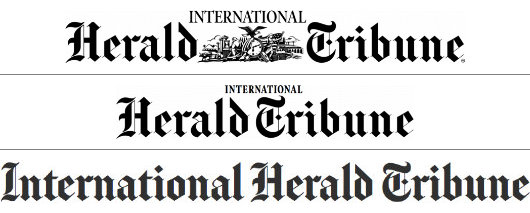
Dropping the dingbat from its nameplate in 2008 was a widely criticised move. One media commentator, Juan Antionio Giner, asserted it was “not a smart strategic decision for a dying newspaper” and compared the decision to “play with such a traditional, magnificent, beautiful, well-done logo” to “moving the chairs on a sinking Titanic”.

The IHT’s new nameplate drops “INTERNATIONAL” from where “NEW YORK” used to sit above the “Herald-Tribune” name and moves it into the main gothic text of the nameplate itself. The result is an overly long banner with a crowded feeling which the designers have apparently (and unsuccessfully) attempted to compensate for with an unbalanced excess of white space above the name. The five-syllable, thirteen-letter “International” is simply too long and cumbersome a word to appear with an equal visual identity to the rest of the newspaper’s name. That’s why it had wisely been placed above the main name in a smaller text size and in a different font from 1924 until 2008. The new design shows that those behind it lack a sense of the Herald-Tribune‘s long and proud history, which they have all too flippantly disregarded.
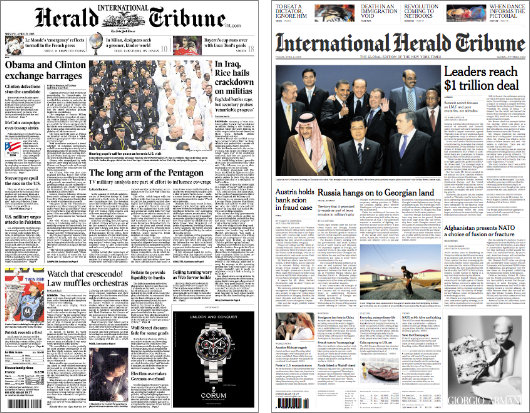
The nameplate issue aside, the rest of the newspaper’s redesign has been along a similar theme of de-emphasizing the newspaper’s identity and rebranding it as an international New York Times-Lite. The structural reorganization of the front page is actually quite successful: an overall rationalization of space usage and better coordination of sight lines and item spacing.
In 2002, the IHT had already dropped the traditional headline font that had been used for a period of over sixty years in favour of the less-elegant but trendier Poynter font. Instead of returning to the traditional Herald-Tribune headline font, the designers have instead opted yet again for Timesification and de-Tribbing, bringing in the Cheltenham typeface used by the New York Times “to lend contrast and openness throughout” (as the Times Company press release put it). Cheltenham is an excellent font, designed by Bertram Grosvenor Goodhue — who vies with Ralph Adams Cram for the title of greatest American architect — but its usage here is both out of place with tradition and another assault on the newspaper’s identity.
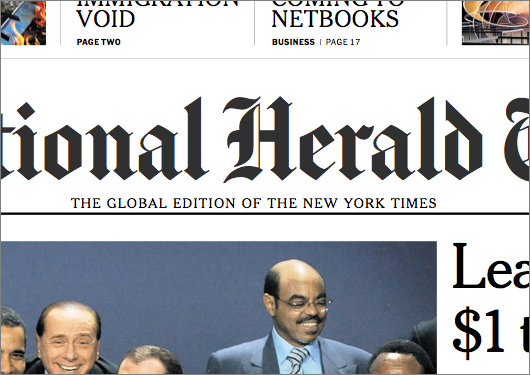
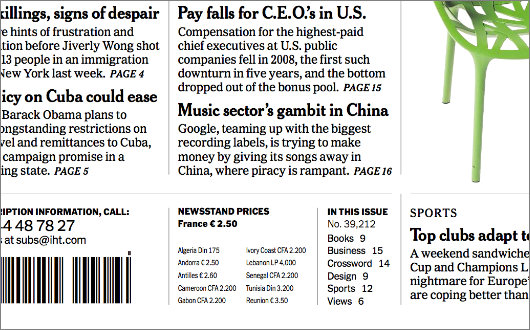
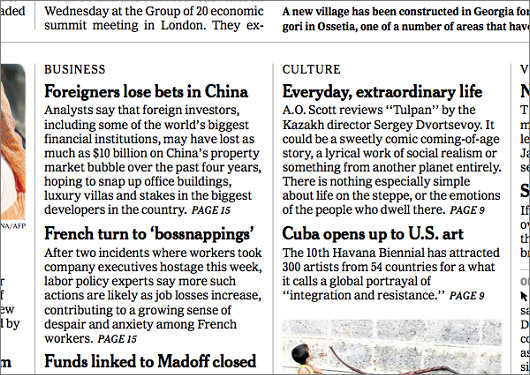
“There oughta be a law…”
“Stripping away the IHT’s own personality is a pity, and it’s a mistake,” writes Philip M. Stone of Follow the Media. Stone describes the new Herald-Tribune as “a mini-NYT” with a “boring” top banner. The redesign, he says, is a “perfect example of why one doesn’t want to buy print any more”. “There ought to be a law against what the New York Times has done to the Herald-Trib”, Stone concludes.
In a Times online question-and-answer session, Times readers tended to salute effusively the new global website. “I really really like this and appreciate the Times even more,” writes one Times reader, while a second shouts “Hoorah!!!” from Pennsylvania. Following the two highly complementary notes from Americans, a Danish reader struck a rather arrogant note, saying “What a great concept! For your American readers! They need to be educated about that weird place, called ‘outside the U.S.'”
Herald-Tribune loyalists, on the other hand, tended to deride the loss of their website.
“I am very disappointed with the new IHT Web site,” writes one. “I have been an avid reader of the International Herald Tribune since I was a boy. My parents, living in Paris, have a subscription and I always enjoyed reading the headlines with breakfast. … As I left for college I set the IHT as my homepage. It was so wonderful to have a constant reminder of my childhood newspaper.”
“However, now that the Web site has changed,” the reader continues, “I now am redirected to a section of The New York Times. I always knew that the IHT was the international version of The New York Times but I still appreciated it as its own entity. It seems silly to ask, but can’t you reclaim your own web site, something the IHT can have as its own, a way of affirming itself onto the web world, independent of The New York Times and as itself? … It’s time the IHT reclaimed what it is due!”
An IHT loyalist in Transylvania struck a similar note: “This morning I turned on my laptop to read the news in the IHT as usual — it’s hard to get the paper edition in Transylvania. And it’s all changed and ugly! I’m sorry to say this, but the IHT was much better on its own. … The feeling, the sense and experience of a different paper has disappeared…”
Reader Alex McCallum writes: “I saw this in your promotional message: ‘Combining the international reporting of The New York Times and The International Herald Tribune.’ That’s fine, as an explanation of The New York Times‘s global edition. But where is the IHT, a newspaper I have been reading since 1965? I can’t find it anymore.”
“It’s still here, in its 122nd year,” responds Mr. Gottlieb, “and going through exciting changes that I think are pretty clear indications it will be here for some time to come.”
“If I wanted The New York Times, I would have bookmarked it,” IHT reader David Cobb retorts. “I am sure this is a cost-cutting measure on your part but please do not insult us by saying it is an improvement. … Are you next going to cease publishing The International Herald Tribune, too?”
End of the line for the Herald-Tribune?
The answer to Mr. Cobb’s question is almost certainly “Yes: the New York Times Company will eventually cease publishing the International Herald Tribune“. At the moment, Times Company decision-makers will whole-heartedly deny this, and truthfully in their minds, for what is taking place is not a conscious decision on the part of the IHT’s owners, but rather a sub-conscious process which will lead to the Herald-Tribune‘s ultimate demise.
Let’s outline the process.
1.First, the Times wrangles ownership of the IHT from its former joint shareholder the Washington Post. It now has complete control over the Paris paper. Joint ownership had created a certain level of stagnation in decision-making over the Herald-Tribune‘s future: major changes had to be taken by two different newspaper companies that had different priorities. Now, power is held just by one company. Complete control, in the right hands, could lead to a re-invigoration of the paper; in the wrong hands, to further stagnation and decline.
2.No longer having to deal with the Washington Post, the Times takes the obvious step of harmonizing the Herald-Tribune‘s role in both the editorial process of the Times newspaper and the business operations of the New York Times Company. At first, this is mostly a behind-the-scenes synchronization, except for the more apparent disappearance of Post content from the IHT’s pages.
3.But declining revenue and sales figures at the Times convince editors and executives of the need to “go further”. This impacts the visual identity of the Herald-Tribune first in the disappearance of its dingbat and now in the removal of its separate website with a concurrent redesign of the entire printed newspaper. Online advertising is now completely integrated between the two titles in the hopes of boosting revenue.
4.With the website gone, the print IHT continues, but with the individuality of its identity removed. It is now little more than, as it proudly proclaims, “the global edition of the New York Times”. We can expect the process of de-Tribune-ification to continue alongside the proprietor’s obvious intent of Timesification. As the harmonization process between the two papers continues, the Times Company is further pressed by falling revenue. Looking at the continued separate existence of the Herald-Tribune, now little more than a different front page nameplate on top of a light-weight version of the Times, the point in the continued expense of maintaining the IHT’s separate identity becomes less justifiable economically.
5.Eventually the Times Company stops publishing the International Herald Tribune, just as Mr. Cobb feared.
Could the IHT go it alone?
Might not the cash-strapped Times Company put the Herald-Tribune up for sale, and the paper continue under different ownership? Unlikely, for a number of reasons. Much of the continued viability of the IHT is due to the printing plants the New York Times Company owns and operates around Europe and Asia. An IHT independent of the Times would no longer have access to this vital and costly aspect of newspaper production, nor to the vast distribution network operated by the Times.
So, if the Times did sell the IHT, it would have to be to a new owner who could invest the necessary capital in order to print and distribute the paper. If such a suitable owner could be found, there is a danger the new International Herald Tribune would compete with the New York Times‘s international coverage and with Times sales in hotels, airports, and newsstands around the world. The quick money the Times Company would earn by selling the Herald-Tribune would have the potential to undercut the company’s profits in the long term by creating a rival.
The Herald-Tribune‘s circulation is about evenly split between three groups: Americans abroad, natives of their own country who desire an international newspaper, and third-country nationals (e.g. a Briton living in Dubai or a German living in Hong Kong, etc.). The Times would not want to cede ground in any of these social groups whose wealth gives the Times a marketing ploy to attract high-paying advertisers both in print and online. Thus, considering the potential threat of an independent IHT to the New York Times, and considering the continued process of integration with the Times under the current leadership, it is likely (though by no means certain) that the New York Times Company will eventually stop publishing the International Herald Tribune and it will die.

The Paris edition of the New York Herald-Tribune was immortalised on the silver screen in Jean-Luc Godard’s À bout de souffle (1960), in which Jean Seberg’s character hawks the paper along the Champs-Elysée.
And so, the prospects are not sunny for the International Herald Tribune. Nonetheless, the newspaper did rise phoenix-like from the ashes of its first New York parent in 1966, and there’s always the possibility of the IHT striking it lucky twice. True, that the paper is under the control of the current leadership of the New York Times, itself a sagging title, does not inspire confidence. But from crisis comes opportunity, for some. Carlos Slim, the Mexican entrepreneur currently ranked as the third richest man on the planet, purchased (in September 2008) a 6.4% stake in the Times Company, making him the largest shareholder after members of the Times‘s founding Sulzberger family. Just four months later he made a $250 million loan to the Times Company, which is currently $1.1 billion in debt. If Mr. Slim, and other investors, can convince the Sulzberger clan to relinquish control of the Company, there is always hope that the fortunes of the New York Times can be turned around, and the International Herald Tribune saved.
Still, the Sulzbergers have held on to the Times since 1896, and have intimated no lack in their zeal to keep going. So, it looks like the ongoing merger between the Times and the Herald-Tribune will continue. “There’s a fatal flaw in the New York Times‘ strategy,” Philip M. Stone writes, “because, put simply, it is the Herald-Tribune that people want to read and not the New York Times.”
Search
Instagram: @andcusack
Click here for my Instagram photos.Most Recent Posts
- Burns Tower April 19, 2024
- Patrick in Parliament March 18, 2024
- Articles of Note: 13 March 2024 March 13, 2024
- Cambridge March 9, 2024
- Taken on Trust March 4, 2024
Most Recent Comments
Book Wishlist
Monthly Archives
Categories



Andrew, a thorough, and sad account of the decline of another great paper.
I hope you have a wonderful Easter. All of your St. Agnes friends miss you.
What has happened to Souren Melikian, the smartest commentator on the art and antiques market worldwide. Has the new IHT (global NYT) kept him as a columnist?
Will we be able to read him online?
The only paper worth reading is the Times of London.
The Times of London is a Rupert Murdoch rag white-washed to look a little more respectable. Their religion reporting for example is really really awful.
Like the IHT the Times of London has a long and respectable history and was once a great newspaper but (again like the IHT) its current owners have driven it into the ground.
If “the only paper worth reading” is the one that thinks Ruth Gledhill is a serious journalist worth employing, then I guess I’m off newspapers.
I don’t argue with much of what’s said in this article. Certainly, The New York Times wants to have a global edition and the IHT is baiscally just the delivery mechanism.
Some things in the article may not be 100% accurate. The dingbat, along with the whole paper (it does mention the switch to Poynter type)was redesigned in 2002-2003.
Also, the New York Times does not own the print sites around the world where the IHT is printed. These are contract printers. Of course the entire supply chain is already set up so it will be easy to pump NYT lite throughout Europe and Asia and NYT doesn’t have the cost of maintaining these facilities.
I sat in on early strategy meetings when the NYT forced out the WP. Even in the first few months of owning the newspaper, many people at the NYT were ready to call the newspaper New York Times International. If it wasn’t for focus groups saying they thought anything that says “New York” on it won’t sell in europe.
While in the early days the tread lightly, heavier footsteps are coming. The IHT will definitely be folded into the NYT at some point.
Erik Zenhausern
Former Operations Director, The Americas
International Herald Tribune
I agree with the comments made by Mr. Harrington in that The Times is no longer the paper it used to be. I try to get the IHT when I can (living in the Scottish Highlands making it very hard). The way Murdoch has tried to rebrand The Times to target a wider group has led to it being a paper that has moved from serious reporting to more tabloid style articles. My father has read The Times for years and I used to, seeing the difference over the years as Murdoch changed it from being a broadsheet to tabloid through transitional steps I can see happening to the IHT by getting folded into the NYT.
Nearly all newspapers are going to die. The Internet is going to gobble them up.
I have very fond memories of reading the IHT when I lived in Europe. Of course, every newspaper is a throwback these days, but they are throwbacks to a more thoughtful, less impatient age. I would like nothing better than to see the IHT survive and prosper with its own identity.
I think internet service providers ought to be taxed, with the proceeds going to fund the salaries of professional journalists.
Thank you for your post.
Oct. 12, 2016, it finally happened: The New York Times International Edition